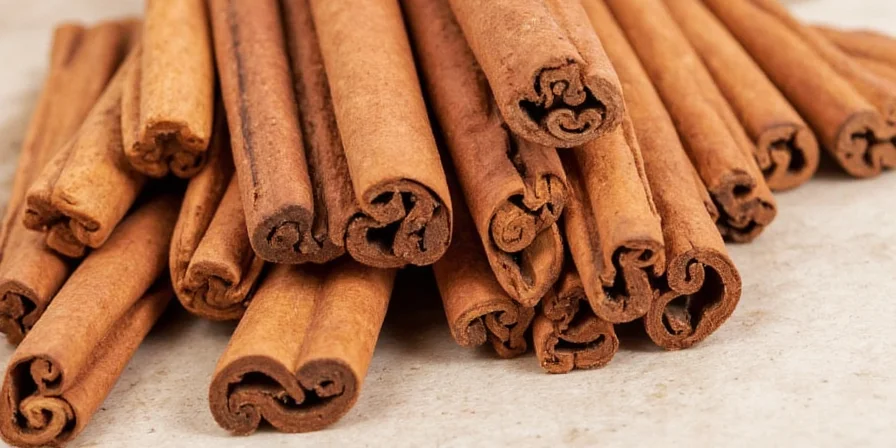Ceylon and Cassia cinnamon differ significantly in safety, flavor, and composition. Ceylon (Cinnamomum verum) contains 63-315 times less coumarin than Cassia varieties, making it the only cinnamon safe for regular consumption. While Cassia dominates 90% of the market due to lower cost, its high coumarin content (2.5-12.18 mg/g) exceeds safe daily limits in just one teaspoon. This comprehensive guide explains exactly how to identify authentic Ceylon, calculate safe consumption levels, and leverage its superior flavor profile in everyday cooking.
Key Differences: Ceylon vs Cassia Cinnamon
The critical distinction lies in coumarin content and structural composition. Ceylon cinnamon, primarily grown in Sri Lanka, features multiple thin bark layers that create a delicate, crumbly texture. Cassia varieties from China and Indonesia have dense single-layer bark with significantly higher oil concentration. European Food Safety Authority studies confirm Cassia contains dangerously high coumarin levels (2.5-12.18 mg/g) compared to Ceylon's minimal amounts (0.004-0.05 mg/g).
This biochemical difference directly impacts safety: the EFSA-established tolerable daily intake (TDI) of 0.1 mg coumarin per kg body weight means just one teaspoon of Cassia powder (2.5g) exceeds safe limits for most adults. Ceylon's negligible coumarin content enables consistent daily use without liver toxicity concerns.
Essential comparison:
| Feature | Ceylon Cinnamon | Cassia Cinnamon |
|---|---|---|
| Coumarin Content | 0.004-0.05 mg/g | 2.5-12.18 mg/g |
| Safe Daily Limit | Up to 6g (1.5 tsp) | 0.5-1g (⅛-¼ tsp) |
| Origin | Sri Lanka / India | China / Indonesia |
| Texture | Thin, layered bark | Thick, rough bark |
| Taste Profile | Mild, sweet, complex | Strong, spicy, bitter |

Health Implications and Safety Thresholds
Regular Cassia consumption creates serious cumulative exposure risks. A standard cinnamon roll contains approximately 1,500 mg of Cassia powder, delivering 22.5 mg coumarin—exceeding the 70kg adult's daily limit (7 mg) by over 300%. This transforms seemingly harmless daily habits into potential long-term health considerations.
Ceylon's unique polyphenol composition provides comparable anti-inflammatory effects at lower consumption volumes, making it valuable for dietary management strategies requiring consistent long-term intake. Unlike Cassia, Ceylon enables safe daily use for blood sugar modulation without liver toxicity risks.

Flavor Chemistry: Practical Cooking Applications
Ceylon's nuanced profile stems from higher cinnamaldehyde (60-75%) and lower eugenol content. This creates gradual flavor release during cooking rather than Cassia's immediate intensity. Professional chefs exploit this in custard-based desserts where flavor integration matters more than immediate impact.
Unlike Cassia's dominant spicy note, Ceylon offers honey-like undertones with citrus hints that remain detectable after prolonged heating. This thermal stability makes it preferable for mulled beverages and slow-cooked dishes.
Practical substitution guide:
- For baking: Use 1 part Ceylon for every 3 parts Cassia
- For beverages: Substitute at 1:1 ratio (Ceylon integrates better in liquids)
- For savory dishes: Stick with Cassia for robust applications like chili

How to Identify Authentic Ceylon Cinnamon
Use these verification methods to avoid counterfeit products:
- Roll test: True Ceylon forms multiple concentric layers when rolled; Cassia cracks
- Solubility check: Ceylon dissolves more completely in warm liquids
- Visual inspection: Look for visible paper-like layers rather than solid bark
- Price benchmark: Authentic Ceylon typically costs 3-5x more than Cassia
- Label verification: Must state "Cinnamomum verum" or "Ceylon" (not just "cinnamon")
When purchasing online, verify sellers through third-party lab testing reports. Reputable vendors provide GC/MS analysis showing coumarin levels below 0.05 mg/g. Avoid products labeled simply "cinnamon" as this legally permits Cassia use in most regions.

Optimal Storage and Usage Guidelines
Maximize shelf life and flavor impact with these techniques:
- Store whole sticks in airtight containers away from light and heat
- Ground cinnamon loses 75% of volatile compounds within 6 months
- For best results, grind sticks immediately before use using a microplane grater
- Infuse whole sticks in dairy-based sauces (1 stick per 500ml)
- Create infused simple syrups (simmer 2 sticks in 1 cup syrup for 15 minutes)
Whole sticks retain optimal flavor for 1-2 years when stored properly. Ground Ceylon maintains significant flavor for only 3-6 months. For cold preparations like smoothie bowls, freshly ground powder delivers maximum flavor impact.

Why Ceylon Is Rare in Grocery Stores
Sri Lanka produces only 8% of global cinnamon volume but commands premium pricing due to strict quality controls. Cassia dominates 90% of the market because Chinese and Indonesian plantations achieve 4x higher yields per hectare through intensive farming practices.
This production disparity creates economic pressure: supermarkets favor Cassia due to 60-70% lower acquisition costs. Specialty retailers now offer traceable Ceylon through blockchain verification—a growing trend responding to consumer demand for transparency and safety.

Practical Implementation Strategy
Transition strategically rather than replacing all cinnamon immediately:
- Maintain Cassia for robust applications like chili seasoning
- Reserve Ceylon for dishes where flavor complexity matters (baking, beverages)
- Start with one application area (e.g., morning coffee or oatmeal)
- Track flavor differences and consumption patterns to determine personal value
The investment pays dividends through enhanced sensory experiences and sustainable consumption practices. When calculating cost per beneficial serving, Ceylon provides better value despite higher upfront cost due to higher safe consumption limits and superior flavor concentration.

Frequently Asked Questions
What's the maximum safe daily intake of Ceylon cinnamon?
Consuming up to 6 grams (approximately 1.5 teaspoons) of Ceylon cinnamon daily remains within safe limits for most adults due to its negligible coumarin content. This represents a 15x higher safe threshold than Cassia varieties.
Can I substitute Ceylon for Cassia in baking recipes?
Yes, but use a 1:3 substitution ratio (one part Ceylon for three parts Cassia). Ceylon's milder flavor requires less volume while providing superior flavor integration in baked goods without coumarin risks.
Does organic certification guarantee Ceylon cinnamon?
No. Organic refers to farming methods, not cinnamon variety. Many organic products still use Cassia. Always verify "Cinnamomum verum" or "Ceylon" on the label regardless of organic status.
How long does Ceylon cinnamon maintain freshness?
Whole sticks retain optimal flavor for 1-2 years when stored airtight in cool, dark conditions. Ground Ceylon loses significant flavor within 6 months. For best results, grind sticks immediately before use using a microplane grater.
Is Ceylon cinnamon worth the higher cost?
Yes, when considering cost per safe serving. Due to higher safe consumption limits and superior flavor concentration, Ceylon provides better value per usable portion despite higher upfront cost. The price difference becomes negligible when calculating cost per beneficial serving.
Ceylon cinnamon is the only variety safe for regular consumption due to its negligible coumarin content. By implementing strategic substitution methods and understanding verification techniques, consumers can enjoy enhanced flavor experiences while eliminating long-term health risks associated with Cassia. The transition requires minimal budget impact when focused on high-value applications where Ceylon's superior properties deliver maximum benefit. Understanding these distinctions transforms a simple spice purchase into an informed decision supporting both culinary excellence and long-term wellness.











 浙公网安备
33010002000092号
浙公网安备
33010002000092号 浙B2-20120091-4
浙B2-20120091-4